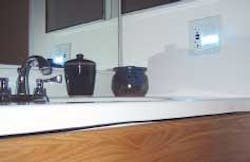Joint project pursues lighting efficiency in hotel rooms
A combination of infrared sensing and light-emitting-diode (LED) technology is on its way into a DoubleTree Hotel in Sacramento, CA, as part of an energy-saving demonstration project in cooperation with the Sacramento Municipal Utility District (SMUD), Lawrence Berkeley National Lab (LBNL; Berkeley, CA), and Watt Stopper (Santa Clara, CA).
The device was designed as part of a study conducted by LBNL researchers and product development engineers at Watt Stopper for three months in the summer and fall of 1998 to improve energy efficiency in the hospitality industry.1 It will be installed in more than 400 guestrooms. DoubleTree and SMUD will share the demonstration costs and LBNL will measure and verify energy savings with funding from the California Energy Commission's Public Interest Energy Research (PIER) project.
The energy-saving device replaces the standard wall switch in hotel bathrooms, uses passive infrared technology to detect occupancy, and turns lights off when the bathroom is vacant. An LED operating in a night-light mode at 10% light output provides energy-efficient illumination when lights are off (see figure).
"We found that one of the largest energy-saving opportunities in hotel-guestroom lighting is eliminating the unnecessary extended operation of the bathroom fixtures," said Berkeley Lab lighting researcher Michael Siminovitch. "More than 75% of the energy used by these fixtures occurs during the occasions that they are left on for more than two hours at a time." Siminovitch and Erik Page of LBNL Environmental Energy Technologies Division conducted the study, which showed that bathroom lights are left on for an average of eight hours in occupied hotel rooms, compared to less than five hours for bedroom lights and two hours for desk lights.
The study results showed an energy consumption peak when the bathroom light was left on for four hours or longer. Hotel managers were reluctant to use standard occupancy-sensing technology to control lighting, however, fearing that guests would become irritated with devices that would douse the lights if the guests were simply in the bathroom for an extended period of time. So the occupancy sensors to be used in the demonstration project were designed with a one-hour delay time that should still provide significant energy savings.
REFERENCE
- http://lighting.lbl.gov/projects/hotel/Hotel.

